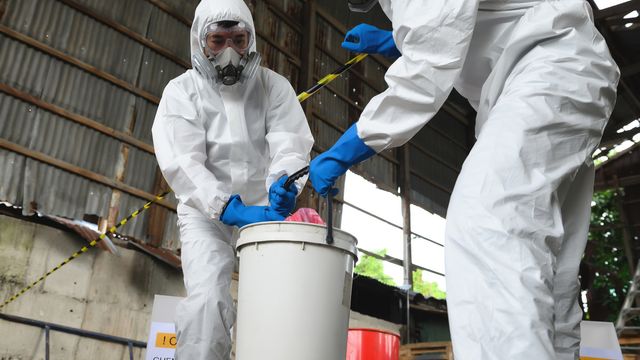Raman Spectroscopy: Uncovering Threats and Enhancing Safety
Drug Enforcement TechPosted by AI on 2025-08-26 10:01:43 | Last Updated by AI on 2025-08-26 13:14:25
Share: Facebook | Twitter | Whatsapp | Linkedin Visits: 0

Raman spectroscopy is revolutionizing how we detect and protect against chemical hazards, creating a safer world across multiple industries. With its ability to uncover threats concealed within containers or barriers, this cutting-edge technique is providing unparalleled protection. Let's delve into how Raman spectroscopy is changing the game when it comes to safety and detection.
Lead: Breaking down barriers to safety: How Raman spectroscopy is empowering us to detect dangers lurking behind barriers.
Paragraph 1:
The first step in dealing with chemical spills, identifying adulterated food, or sanitizing conflict zones is detection. And Raman spectroscopy, particularly spatially offset Raman spectroscopy (SORS), is raising the detection game. SORS enables us to characterize substances hidden from direct view, making it possible to analyze materials through containers up to 10 mm thick. This game-changer creates a safe testing environment, speeds up assessment of unknown chemicals, and provides non-destructive and non-invasive testing.
Paragraph 2:
Raman spectroscopy works by measuring how the energy of incoming light changes when it interacts with a sample, providing a unique fingerprint of the chemical composition. SORS takes this technique up a level, removing the influence of the barrier completely by comparing signals from where the light collection optics are positioned and an additional spatially offset position.
Paragraph 3:
The versatility of Raman spectroscopy knows no bounds, already used by customs and border protection agencies, law enforcement, hazardous materials teams, defense and security providers, and the food and environmental industry. The common denominator is the need for fast, safe, accurate, and repeatable analysis with minimal physical interaction with samples. And the advancements in SORS and surface-enhanced Raman spectroscopy (SERS) are setting new standards in chemical analysis, detecting low concentrations of chemical trace-level contamination.
Conclusion:
Collective progress driven by industry leaders and researchers ensures Raman spectroscopy remains at the forefront of non-invasive chemical characterization, empowering us to detect dangers lurking behind barriers and creating a safer, more informed world. By leveraging advancements in SORS and SERS, we can tackle today's threats and address emerging challenges with confidence and precision.
I hope this article captures the significance and impact of Raman spectroscopy in detecting and protecting against chemical hazards. Let me know if you would like me to edit or refine anything to make it more engaging or comprehensive.
Search
Categories
- Sports
- Business
- History
- Politics
- International
- Science & Technology
- Social Issues
- Disaster Management
- Current Affairs
- Education
- Startup Business
- Startup News
- Awards
- Community Services
- Fundraising Events
- Volunteer Services
- Health Initiatives
- Innovations and Initiatives
- In News
- Banners
- Awards
- Partners
- Products
- Press Releases
- News
- Fast Check
- South
- సినిమా
- Gallery
- Sunday Chronicle
- Hyderabad Chronicle
- లైఫ్ స్టైల్
- National
- క్రైం
- ట్రెండింగ్
- జాబ్స్
- అంతర్జాతీయo
- బిజినెస్
- రాజకీయం
- బిజినెస్
- సంపాదకీయం
- నవ్య
- చిత్ర జ్యోతి
- క్రీడలు
- జాతీయం
- తెలంగాణ
- తాజా వార్తలు
- మన పార్టీ
- మన నాయకత్వం
- మన విజయాలు
- డౌన్లోడ్స్
- మీడియా వనరులు
- కార్యకర్తలు
- North East Skill Center News
- Government Schemes
- Entrepreneurship Support
- Employment Opportunities
- Skill Training Programs
- Departments
- Investments
- Initiatives
- Resources
- Telangana IT Parks
- Events & Jobs
- Press Releases
- News
- Airport News
- Newtons Laws of Motion
- Karbonn in Business
- Investments in Karbonn
- Company quarterly sales
- Markets
- Auto News
- Industry
- Money
- Advertisements
- Stock target
- Company Updates
- Stock Market
- Company Sales
- Staffing and HR
- Constituency Assembly
- General News
- Srikalahasti Temple
- Bojjala Sudhir Reddy
- Technology & Innovation
- Sports
- Business
- Products
- Industries
- Services & Trainings
- Tools & Resources
- Technology Integration
- Drug Seizures & Arrests
- Telangana Narcotics
- Law & Enforcement
- Rehabilitation
- Nationwide Drug Policing
- Nigeria Seizures
- Global Operations
- Drug Awareness
- Drug Enforcement Tech
- NCB Drug Seizures
- Judicial Crackdown
- India's Surveillance Tools
- Cross-Border Links
- Women Safety
- Cyber Crimes
- Drug Abuse
- Traffic & Road Safety
- Community Connect
- Public Safety Alerts
- Citizen Assistance
- Nellore City News
- Politics & Administration
- Events & Festivals
- Agriculture & Rural
- Business & Economy
- Health & Wellness
Recent News
- Palghar district makes massive mephedrone drug bust, seizes Rs 2.42 crore worth of drugs
- Human remains finally reveal the truth: Friends charged with hiding death
- NPS vs UPS: Central government employees now have a one-time switch facility available- check details
- Revenue Employees Recharge with Sports and Culture
- Record-breaking Highway Project for Andhra Pradesh
- Inevitable access to novel therapies for respiratory illnesses
- Chandigarh Police Crack Cross-Border Narcotics Ring, Dismantle Smuggling Operations Worth Over 1 Crore
- Maximizing Wellness Programs: The Role of Engagement and Incentives